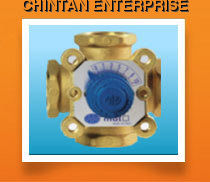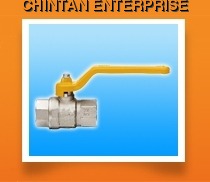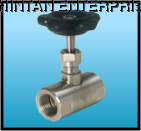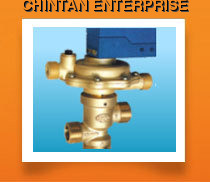Series 3000 Mixing and Deviating Valves
Price 100-300000 INR/ Unit
Series 3000 Mixing and Deviating Valves Specification
- Pressure
- PN16/PN25/PN40
- Connection
- Flanged / Screwed / Welded
- Caliber
- Standard
- Material
- Cast Iron / Cast Steel / Stainless Steel
- Power
- Pneumatic / Electric / Manual
- Media
- Water, Steam, Oil, Gas
- Port Size
- DN15 to DN300
- Flange
- ANSI, DIN, JIS Standard
- Finish
- Epoxy Painted / Polished
- Application
- HVAC, Chemical, Petrochemical, Steam Distribution
Series 3000 Mixing and Deviating Valves Trade Information
- Minimum Order Quantity
- 1 Unit
- Supply Ability
- 100 Units Per Month
- Delivery Time
- 1 Week
About Series 3000 Mixing and Deviating Valves
Series 3000 Mixing and Deviating Valves MOD. VM & 3000R
| MAIN AND OPERATNG CHARACTERISTICS : This type of valve is used in central heating system to guarantee a hot return to the boiler and consequently keep thermal levels high enough to prevent vapor condensation. Mixing, with a linear characteristic curve for delivery and return water, is performed by the shape of the profiled paths. Mixing is done by a rotor with circular segment in the three-way model and by a butterfly rotor in the four-way model. MUT valves are furnishing with manual controls. They can be motorized at any time and without any problems by using MUT V series motors and/or motors marketed by manufacturers of control systems. MUT series 3000 valves are made with a brass body and internal rotor. The rotation angle of the rotor, used for regulation, is approximately 90° and corresponds to the graduations going from 0 to 10 on the identification plate (it is without stops and can consequently rotate 360°). |
FUNCTIONAL CHARACTERISTICS :
|
MATERIALS :
|
Engineered for Versatility and Performance
The Series 3000 valves are designed to provide precise flow control in demanding environments. Their globe-type body, spherical plug, and robust construction allow handling of various media under high pressure. Flexible actuator options, connection types, and finishes ensure compatibility with global industrial standards and easy integration into both new and existing systems.
Reliable Leak Control and Longevity
With seat leakage ratings of Class IV or V (per ANSI/FCI), these valves deliver reliable sealing performance. Corrosion-resistant coatings and gasket materials like PTFE or graphite enhance durability, making them suitable for harsh conditions in chemical and petrochemical plants, as well as HVAC and steam applications.
FAQs of Series 3000 Mixing and Deviating Valves:
Q: How does the Series 3000 valve accommodate different flow requirements?
A: The Series 3000 valve offers both linear and equal percentage flow characteristics, allowing precise control to meet diverse process demands. This versatility ensures stable regulation of water, steam, oil, or gas across various applications and system dynamics.Q: What benefits does the corrosion-resistant coating provide for the valve body?
A: The corrosion-resistant coating enhances the valves durability in aggressive environments, such as chemical plants or steam distribution systems, by protecting against degradation and extending operational life.Q: When should I choose PTFE vs. graphite gasket material?
A: PTFE gaskets provide excellent chemical resistance and are ideal for lower to moderate temperature applications, while graphite gaskets withstand higher temperatures and offer better sealing in steam or high-pressure services.Q: Where can these valves be mounted, and does position affect performance?
A: The Series 3000 valves are designed for both vertical and horizontal mounting orientations, ensuring easy installation without compromising performance or sealing integrity.Q: What is the process for selecting the correct actuator option?
A: Choosing between spring return, double acting, pneumatic, electric, or manual actuation depends on system requirements such as automation needs, fail-safe operation, and control preferences. Consulting technical documentation or the manufacturer will help match actuator type to your specific use case.Q: How do the connection options support global standards?
A: With flanged, screwed, or welded ends compatible with ANSI, DIN, or JIS standards, the Series 3000 valve ensures straightforward integration into international piping systems and broad applicability in export markets.

Price:
- 50
- 100
- 200
- 250
- 500
- 1000+
More Products in Ball Valves SS / CI / CS / MS / GM / PP Category
IC Sight Glass
Price 100-300000 INR / Unit
Minimum Order Quantity : 1 Unit
Material : Other, Borosilicate Glass, Stainless Steel Frame
Pressure : Other, Up to 25 bar
Finish : Polished
Media : Other, Liquid, Gas
Buy Gas Ball Valve
Price 100-300000 INR / Unit
Minimum Order Quantity : 1 Unit
Material : Brass
Pressure : Other, PN16
Finish : Nickel Plated
Media : Gas
SS Needle Valve Screwed End
Price 100-300000 INR / Unit
Minimum Order Quantity : 1 Unit
Material : Other, Stainless Steel (SS 304/316)
Pressure : Other, Up to 6000 psi (415 bar)
Finish : Polished / Machined
Media : Other, Water, Gas, Oil, Steam, Air
3-Way Pressrestatic Shunt Valves
Price 100-300000 INR / Unit
Minimum Order Quantity : 1 Unit
Material : Other, Stainless Steel / Cast Iron / Brass
Pressure : Other, PN16/PN25/PN40
Finish : Polished / Coated
Media : Other, Water / Oil / Gas

 Send Inquiry
Send Inquiry






